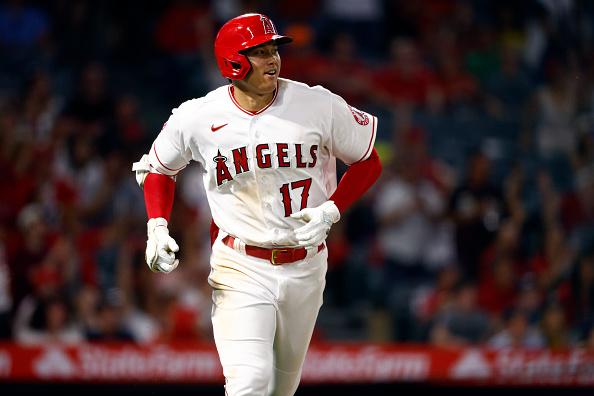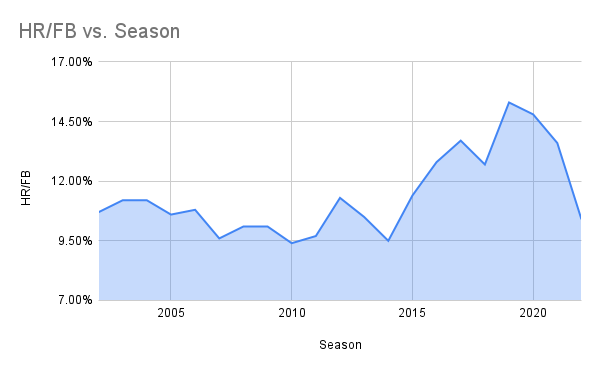What Happened to All the Home Runs?

We're now a couple of weeks into the 2022 MLB season. Noteworthy developments and dazzling early-season results have been covered in the first two editions of Tuma's Take.
We'll be taking a step back today. Instead of focusing on individual player performances we'll be looking at the league as a whole.
This is because home runs are down...a lot. If it continues then it's going to have a significant impact on the landscape of MLB, and by extension, our fantasy baseball leagues.
So let's talk about what's happening, why it's happening, and what (if anything) we should do about it.
What is actually happening?
One of my first pieces to go up on the Underdog Network was titled "No More Juiced Balls: How to Approach Hitters in 2022 Fantasy Baseball Drafts."
It's worth a read (or a re-read) if you missed it over the offseason. League-wide HR/FB% is heavily discussed in it. The reason is because during the Juiced Ball Era we saw more fly balls turn into homers than ever before.
It's important to realize how different the Juiced Ball Era is from the Steroid Era. In the latter, individuals were able to increase the number of homers they hit by making a choice - whether or not to use steroids.
In the Juiced Ball Era, there was no choice. Hitters simply didn't need to impact the ball as hard for it to leave the yard. That led to an increase in round-trippers for ... well, everyone.
Here's the proof:

Now look at that drop-off at the end! Not only is the HR/FB% from 2022 well below what we saw last season, but it's significantly down from the entirety of the Juiced Ball Era (2015-2021). It now looks like the home run environment is trending back towards what we saw from 2002-2014 (Fangraphs batted ball data only goes back to '02).
Additionally, @FreezeStats on Twitter showed that so far this year we're seeing the largest gap between wOBA and xwOBA (spanning the last four Aprils) on barrels.
This is the same idea. Baseball Savant's Statcast system "expects" (xwOBA) these barreled balls to be resulting in more production than they actually are.
However, Statcast is using data from recent seasons to determine these expected results. If a significant change happened, such as deadening the baseball, then the system wouldn't have caught up yet.
These results are simply impossible to ignore.
Note: If you're interested in more analysis of these early-season homer woes you can read Joe Posnanski's Substack, Derek Carty's tweet, and Jeff Passan's latest feature.
Why is this happening?
Let's talk through why this might be occurring.
We'll start with something unique to 2022, which is the shortened spring training. The old adage is that hitters typically take more time to prepare for a season than pitchers, so perhaps arms are just ahead of bats right now?
That might be a factor, but I don't think it's the primary reason. Hitters entered Wednesday batting .231/.310/.373.
In April 2021 hitters hit .232/.309/.390, which is virtually the same triple slash line...except for the slugging percentage (explained by the absence of homers!)
What are some other reasons it could be? The weather? Perhaps, but the 2021 numbers from above are also from April. The HR/FB% in April 2021 was 13.3%. From May through October it was 13.6%. Even if we anticipate a slight increase to the 10.4% mark we're seeing in 2022 (due to the arrival of warmer weather), it would still finish well below the rates we've seen recently.
Pitch com? I have no real way of measuring this and I don't think it can explain what's going on.
Have relievers gotten too good? I like this thought for explaining the decline in batting average. In Posnaski's article he mentions that batters are hitting .243/.321/.391 in innings 1-3 but .223/.305/.371 from innings 7-9 (stats entering April 18th). That's notable, but it doesn't entirely explain the homer issue.
Humidors? From what I understand, the widespread use of humidors across the league should actually lead to more offense in most parks. Whereas the humidor adds water to the air surrounding the balls in drier environments (such as Coors Field), it'll remove water from the air in the most humid locations.
The Athletic's Eno Sarris can explain this effect much better than me.
You might be asking yourself why MLB is installing humidors everywhere then. My thought? To standardize the ball, which brings up to...
The Primary Reason
I'm willing to entertain the notion that all of the aforementioned possibilities are playing a role in the reduced home run rate, but it's impossible to ignore the recent history of the baseball itself.
Entering 2021 it was reported that MLB was intentionally deadening the ball. The league wanted to control the ever-growing home run rates in addition to seeking standardization.
Incredibly, we then learned that MLB used two different baseballs in 2021. This was due to having some "leftover" balls from previous seasons, AKA the juicy ones. This makes sense since the HR/FB% decreased, but not as drastically as it has so far this year.
As far as we know, this is the first true sample size using just the deadened balls.
The results are significant.
So what do we do?
If you believe that MLB's plan is to standardize things, then you should also believe that the 2022 landscape is here to stay. If they succeed we'll see a more stable offensive environment moving forward.
I felt there was a rise in the number of middle class starting pitchers by the end of last summer, and so far that has certainly been the case.
(Of course, the jury is still out on how this plays out throughout the season. This isn't a victory lap.)
I was therefore recommending a hitter-heavy approach to start drafts. This might wind up being my go-to strategy if the deadened ball sticks around, because there just aren't enough usable hitters.
If you weren't able to go hitter-heavy early in drafts, then now is the time to start trading arms for bats. It might not be easy since everyone is hurting for productive hitters, but it's the most actionable advice to take away from the data we've collected so far.
Home runs are disappearing; high-end hitters just became the most sought after commodity in fantasy baseball.